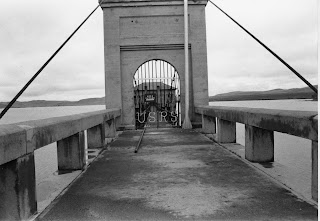
Bliss Mansion
Several years ago, the Carson City Convention and Visitors Authority developed the Kit Carson Trail to promote the Capital City's rich history. The 2.5 mile walking tour through Carson City's west side passes dozens of notable historic homes and buildings.
Emulating Boston's Freedom Trail, which is marked by a brick trail through that historic community, the Kit Carson Trail's path is a bright, blue line painted on sidewalks through the city's most historic neighborhoods.
A walking tour map, available from the convention and visitors bureau office, describes the trail.
Additionally, several of the houses tell their stories. When you stand or park your car in front of any of them and tune a radio to AM 1020 or AM 1040 you can hear recordings telling the history of the two closest homes. The map indicates "talking" houses.
The first 13 places listed in the Kit Carson Trail brochure include the city's most historic government buildings and landmarks including the State Capitol, built between 1870-71, the former State Printing Building, built in 1885-86, the former U.S. Mint (now the Nevada State Museum), built in 1869 and the Governor's Mansion, completed in 1909.
From the state government complex of buildings, the blue line leads to the city's historic churches, largely clustered in the vicinity of Division Street, between King and Telegraph.
These include St. Teresa of Avila Catholic Church (completed in 1871), St. Peter's Episcopal Church (opened in 1868), the First United Methodist Church (1865) and the First Presbyterian Church (1864). The latter is considered the oldest church building still in service in the state while the Methodist Church is the state's oldest religious congregation, established in 1859.
From the churches, the blue line leads into the city's historic residential neighborhoods. The houses range from the modest—such as the 1862 Smail House (512 N. Curry), which is considered a fine example of Greek revival architecture—to the elaborate, like Henry M. Yerington's Victorian home, built in 1863, once home of the superintendent of the Virginia & Truckee Railroad.
Other noteworthy abodes on the trail include: the Alfred Chartz House (412 N. Nevada), built in 1876, and named for a renowned 19th century Nevada lawyer; the Abe Curry House, an unusual sandstone home built in 1871 by the city's founder (using stone from the state prison quarry); and the Frank Norcross House, built in 1906 by a former Nevada Supreme Court Justice (and later owned by former U.S. Senator Paul Laxalt).
One of the most historically significant buildings is the Orion Clemens house (502 N. Division), built in 1863 by the first and only secretary of the Nevada Territorial.
Orion Clemens was the brother of Samuel Clemens, better known as writer Mark Twain. The latter began his writing career at Virginia City's legendary "Territorial Enterprise" newspaper and occasionally stayed in the house in 1864.
The 1886 William Stewart House (503 W. Robinson), named for Nevada's first U.S. Senator, was actually the second home he had constructed in Carson City. It later served as a hospital.
A more recent structure that is architecturally significant is the Dr. William Cavell House (402 W. Robinson). Built by a local dentist in 1907, the house was one of the first in the city to have indoor gas and electricity.
Another striking home is the Bender House (707 W. Robinson), a white, two-story structure with a wonderful round porch. The home was built in 1867 and is named for David A. Bender, a V & T Railroad official, who owned it from 1873 to 1901.
Across the street is the magnificent Bliss Mansion (710 W. Robinson), a 15-room home built in 1879 by lumber magnate Duane L. Bliss. The house is now a bed and breakfast inn.
More about the trail in the next posting.
(For more information about the Kit Carson Trail, contact the Carson City Visitors & Convention Authority, 1-800-NEVADA-1).





